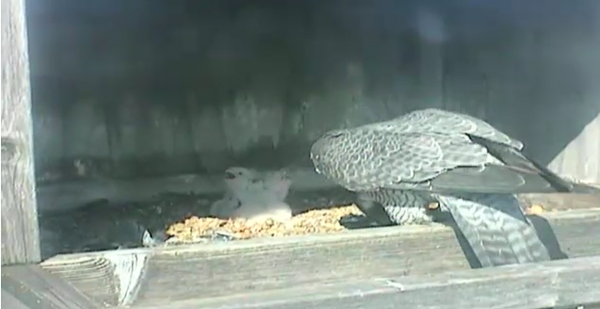


ST. LOUIS (April 27, 2020) — For the ninth year, viewers watched as Ameren Missouri's Falcon Cam captured the moment a baby peregrine chick emerged from its egg. Now the falcon hatchling, and two of its siblings, will call Ameren Missouri’s Sioux Energy Center home for the next six weeks.
Peregrines once nested exclusively on the bluffs along the Missouri and Mississippi rivers, but today these birds often make their homes on tall buildings and structures, such as the ones at Sioux Energy Center in St. Charles County. Ameren Missouri, in partnership with the World Bird Sanctuary and Missouri Department of Conservation, has live-streamed the entire nesting season to give people the chance to watch nature unfold.
"As I'm spending more time with my family, we're enjoying watching one of the newest St. Louis-area families grow and develop right before our eyes," said Kevin Kersting, manager of technical services at Ameren Missouri. "We all feel like proud falcon parents today!"
The goal of the live-stream is to give viewers the chance to witness the early life cycle of these beloved birds up close, while also promoting peregrine falcon conservation efforts. For the past eight years, tens of thousands of viewers from around the world have tuned in from March to June to watch as the falcons raise their chicks.
“People from Missouri and all over the country are learning about the falcons and our partnership's efforts to conserve the peregrine population,” said Jeff Meshach of the World Bird Sanctuary. “Observing their behavior up close helps us protect and preserve them for years to come.”
Viewers have been watching the eggs since mid-March, shortly after both the male and female peregrine parents fashioned their nest and took turns keeping the eggs warm. Now the mother will stay with her chicks to protect the nest while the father ventures out to find prey to feed his growing (and hungry) babies. The chicks will begin to fly in about seven weeks, then will learn how to hunt.
“Before they leave the nest, the chicks' feet will be fitted with tiny tracking numbers. This non-invasive procedure is harmless to the bird and provides researchers with helpful data about its migration patterns,” said Sarah Kendrick, state ornithologist, Missouri Department of Conservation. “The tracking data is housed by the U.S. Geological Survey's nationwide database and can help identify potential threats to the peregrine falcon population.”
Over the years, more than 60 falcon chicks have successfully hatched and returned to the wild from Ameren Missouri facilities without any direct human interaction post tracker tagging. Since beginning Falcon Cam, the peregrine falcon’s population status has improved from “endangered” to “stable” condition, according to the U.S. Fish and Wildlife Service.
Watch all nest activity and interactions live from 7 a.m. until 8 p.m. CDT seven days a week at AmerenMissouri.com/FalconWatch, which also includes clips of fun falcon facts and educational materials, including a weekly blog where Jeff Meshach of the World Bird Sanctuary answers viewer questions.
The camera will stay live until the chicks have left the nest.
Peregrine falcon facts:
About Ameren Missouri
Ameren Missouri has been providing electric and gas service for more than 100 years, and the company's electric rates are among the lowest in the nation. Ameren Missouri's mission is to power the quality of life for its 1.2 million electric and 127,000 natural gas customers in central and eastern Missouri. The company's service area covers 64 counties and more than 500 communities, including the greater St. Louis area. For more information, visit Ameren.com/Missouri or follow us at @AmerenMissouri or Facebook.com/AmerenMissouri.
About World Bird Sanctuary
In 1977 WBS was founded by the late Walt Crawford, and is currently directed by Dawn Griffard. WBS is dedicated to the preservation of all birds and their habitats, and accomplishes this through rehabilitation, education, propagation, field studies, advocacy and services. WBS has been banding Peregrine Falcons since 1985. Through captive breeding and release efforts in the mid to late 80's, WBS is responsible for bringing the Peregrine back to Missouri as a breeding species.
About Missouri Department of Conservation
MDC protects and manages Missouri's fish, forest, and wildlife resources. We also facilitate your participation in resource-management activities, and we provide opportunities for you to use, enjoy and learn about nature.
|
Contact |
Missouri Communications |